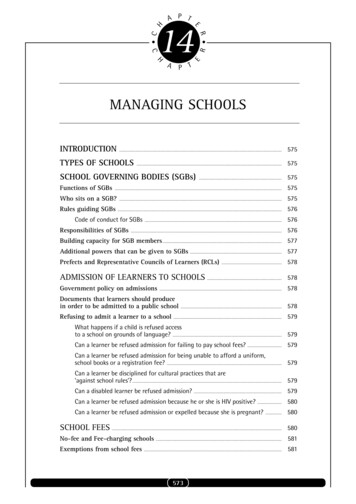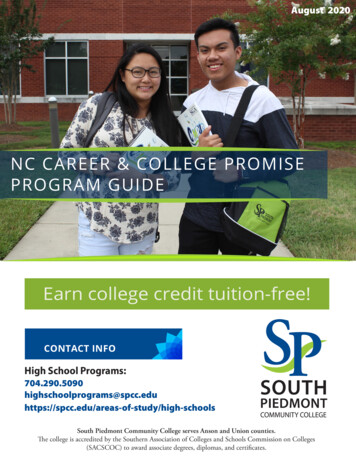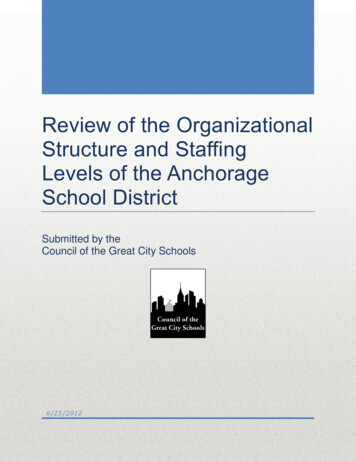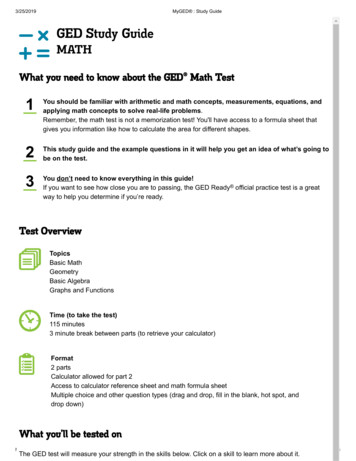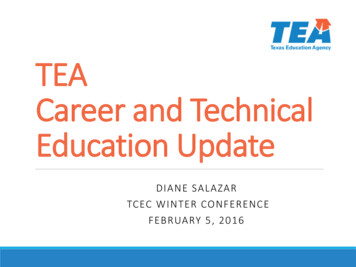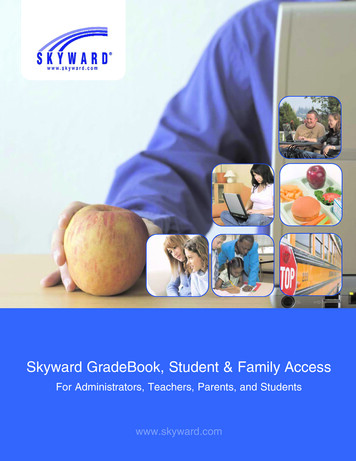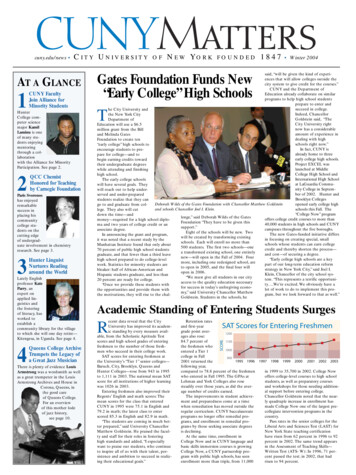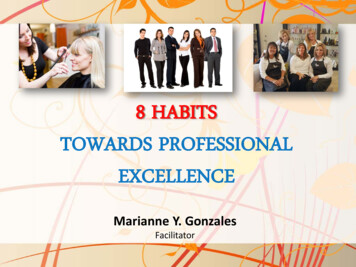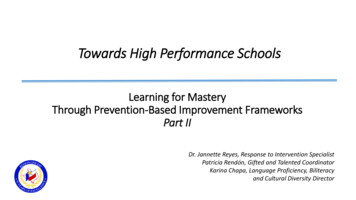
Transcription
Towards High Performance SchoolsLearning for MasteryThrough Prevention-Based Improvement FrameworksPart IIDr. Jannette Reyes, Response to Intervention SpecialistPatricia Rendón, Gifted and Talented CoordinatorKarina Chapa, Language Proficiency, Biliteracyand Cultural Diversity Director
Learning for MasteryThrough Prevention-Based District-Improvement Framework StrategyShared VisionLearning DesignsEnvironment Culture of Success Turn-AroundCompetencies Monitoring usFocus Content andPedagogy Assessment forLearning Learning Community Academic Supports Behavioral SupportsREACHING NEWHORIZONS 2017 Region One Education Service Center
StudentFocusBEFOREREACHING NEWHORIZONS 2017 Region One Education Service Center
Learning for Mastery: Focus on Instructional onalDeliveryHigh gREACHING NEWHORIZONS 2017 Region One Education Service Center
Dr. John HattieWhat works in schools?20 years of researchImage URL: 08/john-hattie.png
195 Influences- 1200 meta analyses- 65,000 studies- 250 million students(Hattie, Masters, & Birch, 2015)
*Hattie Ranking*using Cohen’s d formulafor reporting effect ING NEWHORIZONS 2017 Region One Education Service Center
Image URL: /s1600/Hattie%2Bbarometer.PNG 2017 Region One Education Service CenterREACHING NEWHORIZONS
Rating Implications- 0.02 Cause harmful effects on student achievement.1Students experience one-fourth of a years’ growth in one year0.2Students experience half a years’ growth in one year0.4Students experience one years’ growth in one year0.8Students experience two years’ growth in one year1.2Students experience three years’ growth in one year1.6Students experience four years’ growth in one year1.6 More than four years’ growth in one yearREACHING NEWHORIZONS 2017 Region One Education Service Center
Identifying What MattersImage URL: /03/pie-chart.pngREACHING NEWHORIZONS 2017 Region One Education Service Center
“The biggest message of hope andoptimism in our field of practice is thatnearly every practice that is above a 0.4effect size is directly within the teacher’scontrol or the teacher’s influence.”(Anderson, 2017)REACHING NEWHORIZONS 2017 Region One Education Service Center
Task – Purpose for Listening*using Cohen’s d formulafor reporting effect ING NEWHORIZONS 2017 Region One Education Service Center
Create a diagram that shows the sequence and/orthe relationship between these two concepts Positive student outcomes Changes in teacher practicesREACHING NEWHORIZONS 2017 Region One Education Service Center
RemediationREACHING NEWHORIZONS 2017 Region One Education Service Center
*Instructional Core Support* With high-qualityimplementation practicesthat focus on building andmaintaining Tier 1.Shoreline Public Schools, 2017REACHING NEWHORIZONS 2017 Region One Education Service Center
“We can’t refer the studentuntil he has been RtI-ed.”(RtI has become a verb.)“We need to RtI the studentbefore they go to special ed.”(RtI is used as a pre-referral process)“They said I have to fill outthe RtI forms to give to theRTI Committee.”(RtI is forms-driven) How long does the studentneed to be in RtI before wecan move him to Tier ?(The purpose of RtI is misunderstood.)16
Acceleration Remediation:High-Impact Instructional Approaches for Academically Challenged Students AccelerationRemediation Key PrerequisiteSkills/Concepts Key Prerequisite/NewVocabularyInstructionalEpisode 1InstructionalEpisode 2 AccelerationRemediation Key PrerequisiteSkills/Concepts Key Prerequisite/NewVocabulary AccelerationRemediation Key PrerequisiteSkills/Concepts Key Prerequisite/NewVocabularyInstructionalEpisode 3REACHING NEWHORIZONS 2017 Region One Education Service Center
(Rollins, 2014)REACHING NEWHORIZONS 2017 Region One Education Service Center
REACHING NEWHORIZONS 2017 Region One Education Service 2015/10/6a00e55187f8f6883401a3fcf12dbe970b.png
Teacher EfficacyTeacher efficacy – teachers’ confidence intheir ability to promote students’ learning.“I can”(Hoy, 2000)Collective teacher efficacy is defined as “theperceptions of teachers in a school that theefforts of the faculty as a whole will have apositive effect on student achievement.”“We can”(Goddard, Hoy, and Hoy, 2000)REACHING NEWHORIZONS 2017 Region One Education Service Center
Reflection*using Cohen’s d formulafor reporting effect ING NEWHORIZONS 2017 Region One Education Service Center
AccelerationREACHING NEWHORIZONS 2017 Region One Education Service Center
The Power of Acceleration: Scenario 150mph25mphREACHING NEWHORIZONS 2017 Region One Education Service Center
The Power of Acceleration: Scenario 150mph25mphREACHING NEWHORIZONS 2017 Region One Education Service Center
The Power of Acceleration: Scenario 250mph50mphREACHING NEWHORIZONS 2017 Region One Education Service Center
The Power of Acceleration: Scenario 250mph50mphREACHING NEWHORIZONS 2017 Region One Education Service Center
The Power of Acceleration: Scenario 350mph75mphREACHING NEWHORIZONS 2017 Region One Education Service Center
The Power of Acceleration: Scenario 350mph75mphREACHING NEWHORIZONS 2017 Region One Education Service Center
ELL ProgressTypical Native Speaker 50th percentile in L1 One year progress 10 months765432English Learners 25th percentile in L2 1 year progress 10 months1(Thomas & Collier, 2001)http://www.crede.ucsc.edu/research/llaa/1.1 final.html 2017 Region One Education Service CenterREACHING NEWHORIZONS
1yearImage URL: /s1600/Hattie%2Bbarometer.PNG 2017 Region One Education Service CenterREACHING NEWHORIZONS
Which influences will help our students acceleratemore than 1 year every school year?*Using Cohen’s formula forreporting effect ING NEWHORIZONS 2017 Region One Education Service Center
The Acceleration Framework1.2.3.4.5.6.Generate thinking, purpose, relevance and curiosityClearly articulate the learning goal and expectationsScaffold and practice essential prerequisite skillsIntroduce new vocabulary and review prior vocabularyDip into new conceptConduct formative assessments frequentlyREACHING NEWHORIZONS 2017 Region One Education Service Center
Introduce new vocabulary andreview prior vocabulary
What does this mean?Carving is appropriate for most green andblue slopes and even some black slopes.However, if you try to carve throughmoguls, especially in packed powder orcorn snow, you’re going to face-plant.REACHING NEWHORIZONS 2017 Region One Education Service Center
What does this mean?Carving is appropriate for most green andblue slopes and even some black slopes.However, if you try to carve throughmoguls, especially in packed powder orcorn snow, you’re going to face-plant.REACHING NEWHORIZONS 2017 Region One Education Service Center
Would this help?These men are carvingREACHING NEWHORIZONS 2017 Region One Education Service Center
How about this?Green SlopeBlue SlopeBlack SlopeREACHING NEWHORIZONS 2017 Region One Education Service Center
MogulsPacked PowderREACHING NEWHORIZONS 2017 Region One Education Service Center
Corn SnowREACHING NEWHORIZONS 2017 Region One Education Service Center
Face PlantREACHING NEWHORIZONS 2017 Region One Education Service Center
apropiadoCarving is appropriate for most green and blue slopesand even some black slopes. However, if you try to carveespecialmentethrough moguls, especially in packed powder or corn snowyou’re going to face-plant.
Reflection*Using Cohen’s formula forreporting effect ING NEWHORIZONS 2017 Region One Education Service Center
Dip into new concepts
Frayer Model with a Creative TwistColorWeather ConditionEvolutionSeasonSongREACHING NEWHORIZONS 2017 Region One Education Service Center
Frayer Model with a Creative TwistColorReason:Weather ConditionReason:EvolutionSeasonSongLet It Go!Reason:Reason:REACHING NEWHORIZONS 2017 Region One Education Service Center
Reflection*Using Cohen’s formula forreporting effect ING NEWHORIZONS 2017 Region One Education Service Center
Conduct formative assessmentsfrequently
Checking for Understanding:Immediate Feedback and Corrective ActionREACHING NEWHORIZONS 2017 Region One Education Service Center
Answers on cardsReady ResponsesWritten ResponsesPersonalChalkboardsOpen hand/closedhandThumbs up/downRankingTotalResponseSignalsWhite boardsHands up whenreadyThinker’s chinStand up when readyPut your pen on yourpaper when readyAll eyes on teacherMaking ChoicesStrategies toCheck forUnderstanding:Hold up paperNumber wheelsRank with yourfingersRank with your armGreen card/red cardLine up according toresponseMove to thecorner/spotKnocking/clapping/cheeringREACHING NEWHORIZONS 2017 Region One Education Service Center
Reflection*Using Cohen’s formula forreporting effect ING NEWHORIZONS 2017 Region One Education Service Center
A rising tide lifts all boats.John F. KennedyREACHING NEWHORIZONS 2017 Region One Education Service Center
Situationally Defined Achievement DiscrepancyPeterson and Shinn, 2002REACHING NEWHORIZONS 2017 Region One Education Service Center
High Quality Enrichment/Extension Activities:Instructional Approaches for Mastery StudentsInstructional Episode Diagnostic Opportunities to PursueInterests Extend Understanding Peer Projects Academic Games
itorProgressMonitorProgressMonitor
Tic Tac ToeDifferentiatedInterventionsREACHING NEWHORIZONS 2017 Region One Education Service Center
https://exoplanets.nasa.gov/trappist1REACHING NEWHORIZONS 2017 Region One Education Service Center
How to Write Tic Tac ToeStudent Activities1. Determine unit objective/ goal (focus on TEKS).2. Write many TEKS-supporting activities(formative/summative).3. Write each activity on post-it notes.4. Place notes on the Tic Tac Toe grid.5. Check configuration, move as needed, and type ontothe grid.6. Provide easy to understand criteria for each activity.REACHING NEWHORIZONS 2017 Region One Education Service Center
1.Create a new characterthat can be added to thestory. How will thischaracter change theoutcome of the story.4.2.Produce a 3-min videonews report about anincident in the storyinvolving 1 or morecharacters.5.6.8.Create a new part of aplant. What purpose willthis new part serve? Howwill it improve the life of aplant?Design a report card forat least 3 characters.Include grades for eachcriteria and commentsto supportCreate a geometriccharacter analysis ofseveral characters usingdifferent shapes torepresent the character.Create a new continent.What kind of climate,crops, government,currency, andinhabitants will it have?7.3.Dress like your favoritecharacter and role playan important part ofthe story.9.Write an epilogue tothe story that tellswhat happens next.Read it to the classWrite a letter to acharacter in the storytelling the story froma different point ofview.
1.2.Create acharacter mapfor your favoritecharacter in thestory. Show bothCharacter traitsand events.Produce a 3-minvideo newsreport about anincident in thestory involving1 or morecharacters.5.V6.VDress like yourfavoritecharacter androle play animportant partof the story.V8.Draw a VennDiagram tocompare the 2main charactersVCreate a geometriccharacter analysisof severalcharacters usingdifferent shapes torepresent thecharacter. ExplainCreate a BookJacket withcharacterdescription onthe inside flap ofat least 2characters7.Design a reportcard for at least3 characters.Include gradesfor each criteriaand commentsto supportAV4.3.K9.Write anepilogue to thestory that tellswhat happensnext.Read to theclassAWrite a letterto a characterin the storytelling how hislife is likeyours or how itis differentfrom yours.V
Reflection*using Cohen’s d formulafor reporting effect ING NEWHORIZONS 2017 Region One Education Service Center
A Cheetah MetaphorThe cheetah is the fastest animal onearth.Is it still a cheetah? When we think of cheetahs weare likely to think first of theirspeed. It's flashy. It isimpressive. It's unique. And itmakes identification incrediblyeasy. Since cheetahs are the onlyanimals that can run 70 mph, ifyou clock an animal running 70mph, IT'S A CHEETAH! If a cheetah has only 20 mphrabbits to chase for food, itwon't run 70 mph while hunting.If it did, it would flash past itsprey and go hungry! whengiven only rabbits to eat thehunting cheetah will run onlyfast enough to catch a rabbit.Stephanie S. Tolan, 1996
ReflectionWhat implications does thisinformation have for you asyou plan for continuousimprovement?REACHING NEWHORIZONS 2017 Region One Education Service Center
ReferencesHattie's new #1 effect size: Collective teacher efficacy [Video file]. (2017, March 09). RetrievedMarch 7, 2019, from https://www.youtube.com/watch?v KY6erhLDOdE&feature youtu.beHattie, J., Masters, D., & Birch, K. (2015). Visible learning into action. New York, NY: Routledge.Hoy, A. W. (2000) Changes in teacher efficacy during the early years of teaching. Paper presented atthe Annual Meeting of the American Educational ResearchThomas, W. & Collier, V. (2001) A National Study of School Effectiveness for Language MinorityStudents’ Long Term Academic Achievement. Center for Research on Education, Diversity andExcellence.REACHING NEWHORIZONS 2017 Region One Education Service Center
Division of Instructional, School Improvement, andCollege Readiness SupportDr. Eduardo Cancino, Deputy Director956-984-6022ecancino@esc1.netBelinda S. Gorena, AdministratorSchool Improvement, Accountability and Compliance956-984-6173bgorena@esc1.netKelly K. VanHee, AdministratorCurriculum, Instruction and Assessment956-984-6151kkvanhee@esc1.netCarmen Garcia, DirectorBrownsville Extension Office956-984-6231cagarcia@esc1.netDarlene M. Rogers, DirectorLaredo Extension Office956-795-0000drogers@esc1.netREACHING NEWHORIZONS 2017 Region One Education Service Center
Towards High Performance Schools Learning for Mastery Through Prevention-Based Improvement Frameworks Part II Dr. Jannette Reyes, Response to Intervention Specialist
